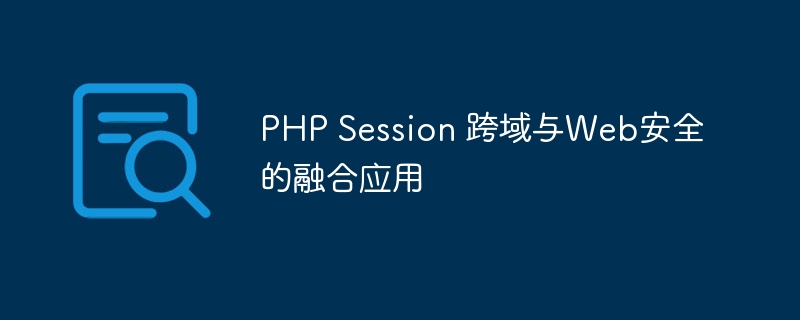

PHP Session Integrated application of cross-domain and Web security
With the development of Internet technology, the development of Web applications has become common and increasingly complex. The security of web applications is particularly important when dealing with user authentication, rights management, and data protection. The use of the PHP Session mechanism can help us achieve these goals. This article will describe how to integrate PHP Session with cross-origin requests and web security, and provide specific code examples.
Cross-domain request means that the browser requests resources under another domain name from the web server under one domain name through XMLHttpRequest or Fetch API. Due to the browser's same-origin policy, cross-domain requests are prohibited by default. In actual web applications, cross-domain requests are very common, such as using third-party APIs or sharing resources across domains. When handling cross-domain requests, we need to take some security measures to prevent potential security vulnerabilities.
PHP Session mechanism is a server-side session management solution that can help us track the user's login status, save user data, etc. By using PHP Session, we can share user information between different pages and implement login status verification. The following is an example to illustrate how to use the PHP Session mechanism in conjunction with cross-domain requests.
Suppose we have a web application with a domain name of example.com and need to handle cross-domain requests from another domain name api.example2.com. Our goal is to verify that the request from api.example2.com has a valid Session and return the corresponding user information.
First, create a PHP file auth.php under example.com to verify the user's login status:
session_start();
// 检查是否存在有效的登录Session
if (!isset($_SESSION['user_id'])) {
header('HTTP/1.1 401 Unauthorized');
exit;
}
// 根据用户ID获取用户信息,这里假设有一个函数getUserInfo()用于从数据库中获取用户信息
$user = getUserInfo($_SESSION['user_id']);
// 返回用户信息
echo json_encode($user);Then, we initiate a cross-domain request to example under api.example2.com. com's auth.php interface, include SessionID in the request:
fetch('https://example.com/auth.php', {
method: 'GET',
credentials: 'include', // 允许发送Session Cookie
headers: {
'Content-Type': 'application/json'
}
})
.then(response => {
if (!response.ok) {
throw new Error('Unauthorized');
}
return response.json();
})
.then(data => {
// 处理返回的用户信息
console.log(data);
})
.catch(error => {
console.error(error);
});In the above example, we set the credentials of fetch to 'include' to allow the browser to send Session Cookie to ensure that it can be used in cross-domain requests. Pass Session correctly. At the same time, auth.php verifies the request. If there is no valid login Session, a 401 Unauthorized error will be returned.
In this way, we can combine the PHP Session mechanism in cross-domain requests to verify the session and obtain user information. However, it should be noted that when using PHP Session, some web security measures need to be taken to prevent security threats such as Session hijacking and cross-site scripting attacks.
In order to increase security, you can configure Session security options in php.ini, such as using HTTPS to transmit Session Cookies, setting the Session life cycle, disabling automatic Session ID, limiting Session storage location, etc.
In addition, in order to prevent cross-site scripting attacks (XSS), when outputting Session data to the page, appropriate escaping and filtering measures should be taken to ensure the security of user data. For example, use the htmlspecialchars() function to escape output user data to prevent malicious scripts from being injected into the page.
In summary, the integrated application of PHP Session mechanism, cross-domain requests and Web security is an important part of realizing secure Web applications. By properly using PHP Session and corresponding security measures, we can protect the user's login status and sensitive data when processing cross-domain requests and improve the security of web applications.
Through the above code examples and security suggestions, we hope to help readers better understand and apply the PHP Session mechanism and improve the security of web applications. At the same time, we also remind everyone that in actual development, appropriate security measures must be taken based on actual needs and security risks to protect user privacy and data security.
The above is the detailed content of PHP Session cross-domain and web security integration application. For more information, please follow other related articles on the PHP Chinese website!